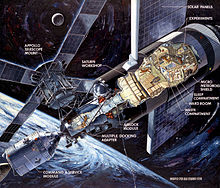Apollo application program
The Apollo Applications Program (short, English AAP Apollo Applications Program ) was a space project of the United States . It was launched in August 1965 by the National Aeronautics and Space Administration (NASA) and arose from the desire to use the hardware of the Apollo program for other scientific missions beyond the moon flights .
The only planned project that actually took place was the Skylab space station , and so the Apollo Applications Program was officially renamed the Skylab Program on February 17, 1970 .
Origins
In 1965 and 1966 studies began to supplement the spaceships ( Crew and Service Module , CSM), lander ( Lunar Module , LM) and Saturn launch vehicles of the Apollo missions and to use them for other purposes, with a focus on scientific missions. At this point in time, the extent of the lunar landing emissions was still unclear and the exact number of aircraft required had therefore not yet been defined.
Moon base
Under the name AES (Apollo Extension Series), a concept for a lunar base was investigated before 1965 . An unmanned Saturn V rocket would have brought a CSM-based housing to the moon, while a second Saturn V would have landed the usual two-man crew. This configuration, which also provided for a rover and a small rocket aircraft, would have allowed a stay of up to 200 days; The isolation of the CSM pilot, who would have remained alone in the lunar orbit during this time, presented a particular challenge. Therefore, there were also considerations to land the entire crew and leave the CSM autonomously in orbit. The study was planned in four phases until the mid-1970s, with some of the requests ( rover , handcart , three-day stay) actually being implemented in the later Apollo 15 through Apollo 17 missions .
Extended lunar base
The programs ALSS ( Apollo Logistics Support System ) and LESA ( Lunar Exploration System for Apollo ) were planned as a further development of the AES . New, more powerful landing ships such as the five-tonne load-bearing LM truck and mobile laboratories, a nuclear reactor for energy supply on the surface of the moon, as well as stays for two people over 30 days (ALSS) or up to six people and 180 days (LESA ). There was no concrete planning.
Emergency climbing device
In the event of failure of the lunar module's ascent stage , NASA investigated a few simple concepts for putting two astronauts into orbit to the CSM waiting there.
Manned Venus flyby
Another idea was to bring a Saturn V on a return course to Earth with a flyby of Venus . No LM would have been required for this mission, so the Saturn V could have achieved the required speed. The astronauts would have made the S-IVB rocket stage, which had burned empty, habitable (so-called “wet workshop” concept) and would only have switched back to the CM shortly before returning to Earth.
Space station
There were various proposals for space stations that should serve as manned orbital laboratories . In addition to the Skylab , which was finally implemented , which largely consists of an empty rocket stage, there was, for example, the desire for a much more spacious research facility with an integrated 3-m space telescope . A more favorable design is the modification of the LM as an orbital laboratory, which would have been launched at the same time as a complete Apollo spacecraft and equipped with experiments instead of the ascent stage. Positioning a space station in orbit around the moon was also discussed.
development
After 1968, as a result of budget cuts, planning focused on three different concepts:
- an Apollo Telescope Mission (ATM) on earth orbit to study the sun, consisting of components of the LM and powered by solar cells;
- an Apollo Manned Survey mission in high inclination orbit for Earth observation;
- a concept of a space station based on an empty S-IVB as a “wet workshop” in earth orbit.
Missions
In 1969 the focus shifted to the concept of a space station after it became clear that the smaller Saturn IB rockets would also be available. Skylab consisted of old and new Apollo modules, implemented essential features of the Apollo Telescope Mission and was finally built as a ready-to-use "dry workshop". Despite a glitch during launch that caused significant damage to the space station, the program was a complete success and was manned three times in 1973/74.
After the last occupation, Skylab still had crew supplies for 180 days. NASA assumed that the station could continue to be used with the space shuttle and was planning the STS-2a mission to restart. But as early as 1979 - before the first shuttle take-off - the last Apollo application with Skylab had to be abandoned because of unexpected height losses and failures.
See also
Individual evidence
- ^ Apollo Application Program. nasa.gov, August 6, 1965, accessed September 12, 2012 .
- ↑ Roland W. Newkirk, Ivan D. Ertel, Courtney G. Brooks: PART III: Skylab Development and Operations: February 1970-November 1974. In: Skylab: A Chronology. NASA, 1977, accessed September 13, 2012 .
- ↑ TR-67-600-1-1 Manned Venus Flyby study - Feb. 1, 1967. (PDF; 6.7 MB) nasa.gov, February 1, 1967, accessed on September 12, 2012 (English).


